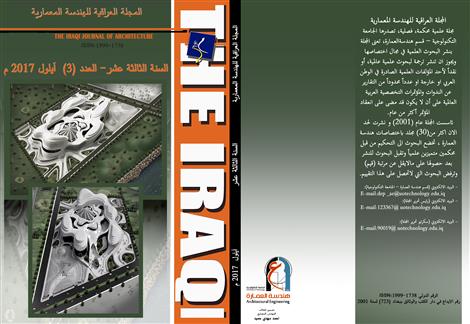Employing natural lighting systems technology in raising environmental efficiency in educational buildings
Abstract
Studies were carried out to increase dependence on day lighting to illuminate the buildings because of their psychological and health benefits ,and recent research has shown that exposure to artificial lighting for long periods cause health damage. As a result, many modern and sophisticated systems has emerged to introduce day lighting into the building to integrate with the traditional system (windows). These systems are based on advanced technology and can be available at relatively low cost, especially light tubes that integrated with traditional lighting (windows) to light deep spaces. Hence this research introduces new methodology added by using one of the modern lighting systems (light tubes) in the design process of buildings, and achieve coherence and efficiency in lighting levels inside the deep spaces by combining traditional and modern system, using computer. Hence the research problem consists in the lack of local studies that link traditional systems (Windows) and modern systems, particularly light tubes to light up the deep spaces. The goal of the research, is to integrate traditional systems (Windows) and modern systems, (light tubes), within a unified practical framework to employ light tubes locally in buildings. So this paper first dealt with day lighting technology systems and then chose the (light tubes) for its high efficiency, and distinctive characteristics apart from being inexpensive. Then the study adopted the rate of uniformity concluded from the application practical side to determine lighting levels and the efficiency of the merger between the two systems down to the final conclusions of the framework and the imposition of hypotheses.
Downloads
References
• Baroudi, Izzat, 2012. "Useful brief in Interior Lighting Design"( almukhtasir almufid fi tasmim alanarat alddakhilia)[Arabic], First Edition, IP: 44.
• Shahin, Bahgat Rashad, 1990. (Architecture and climate in dry hot areas)( aleamarat w almunakh fi almanatiq alharat aljafa)[Arabic]. Continuing Education Course 7.
• Fawzi, Yousef Wajih, 2010. (The Effect of Natural Lighting on the Form of Buildings) ( tathir al'iida'at altabieiat eali shakal almabani)[Arabic], Center for Planning and Architectural Studies. Research. Http://www.cpas-egypt.com/AR/WagihFawzi_en.html. pp. 1-11.
• Natural Lighting Blog, PO Box 506, 2013. Ministry of Construction and Housing, General Authority for Buildings, Ministry of Planning, Central Organization for Standardization and Quality Control, First Edition, Iraq, Baghdad,
• Berhad , Sirim , “Lighting of indoor work places†, Malaysian Standard , ISO : 8995 , IDT , 2002 , p.4 .
• Chai-kwong , Mak , “The public Lighting Design Manual†, 2nd edition , Garden Road , Central , Hong Kong , 2006 , p.36 .
• Dubois, Catherine & Demers, Claude, “The Influence of Daylighting on Occupants ; Comfort and Diversity of Luminous in Architectureâ€,, University of Laval, CANADA, conference Proceedings of the American Solar Energy Society (ASES), SOLAR 2007, 7-12 July, Cleveland, Ohio , p.18 .
• Environmental Building News "Daylighting: Energy and Productivity Benefits", Vol. 8, No. 9, Sept 1999.
• Hansen, Veronica Garcia, “ Innovative Daylighting Systems for Deep-Plan Commercial Buildings†Ph.D. thesis submitted to Queensland University of Technology,2006,p.32,64 .
• Meterbaei, Monzer E-& Abu El-Kair, Reem. “Openings “Lecture No.4, 23-11-2008. Pp .( 19-21).
• Moses, Nalina, “Daylighting Systems. Before Nightfall: Advanced Daylighting Technologies “. The American Institute of Architects (AIA) Magazine. Vol. 19. September 28, 2012
• Muhaisen, Ahmed S & Dabbor Hazem R, ‘Studying the Impact of Orientation, Size, and Glass Material of Windows on Heating and Cooling Energy Demand of the Gaza Strip Buildings†, Architecture Department, Faculty of Engineering, Islamic University. Journal of Architecture and Planning, Vol. 27 (1), Riyadh (2015/1436H.). 2015. pp. 1-15.
• Parpairi, K., ‘Daylight perception’, in: Steemers, K. and Steane, M. A. (ed.), Environmental Diversity in Architecture, p. 179-193, Spon Press, London, 2004.
• Solatube , “Specifying daylight for commercial projects†, Olney office park , Olney , England , 2015 , p.4 .
Copyright (c) 2019 Younis Mahmood Saleem, Saif Aldeen Saad Aldeen Saad Abdul-Hameed

This work is licensed under a Creative Commons Attribution-ShareAlike 4.0 International License.
You are free to use the work, but you have to attribute (refer to) the work in the manner specified by the author or licensor (but not in any way that suggests that they endorse you or your use of the work).
IRAQI J. ARCHIT & PLANN grants you the right to publish the metadata of the journal, it's issues and articles under the terms of the Creative Commons Attribution-ShareAlike 4.0 International License.
Author(s) hold the copyright of their aricles without restrictions. However, IRAQI J. ARCHIT & PLANN holds publishing rights for articles and their revisions once the article is published.
Authors can archive pre-prints (ie pre-refereeing) and post-prints (i.e. final draft post-refereeing) versions of the work they submitted to IRAQI J. ARCHIT & PLANN using non-for-profit open-access servers whether on author's personal website and/or institutional repositories including the university or research center where the author work.. For post-prints, only the IRAQI J. ARCHIT & PLANN’s as-published PDF version is permitted and the published source (IRAQI J. ARCHIT & PLANN’s website) must be clearly acknowledged within the archiving webpage.






